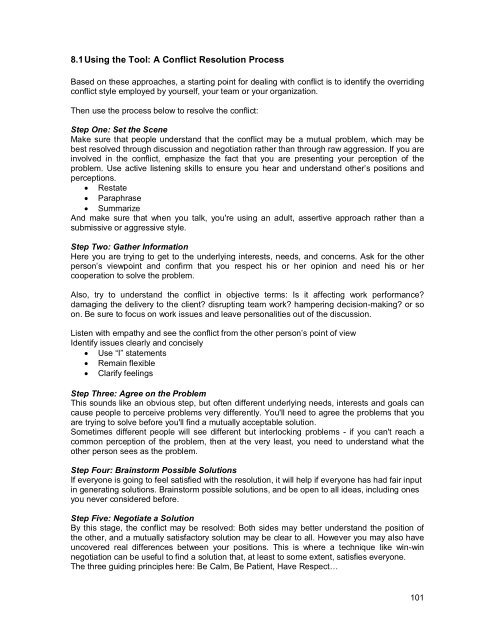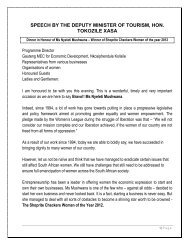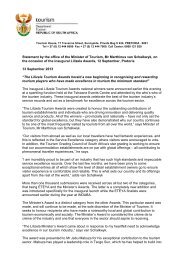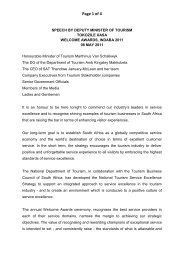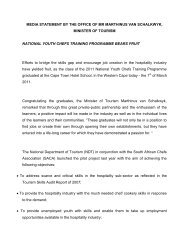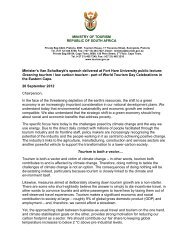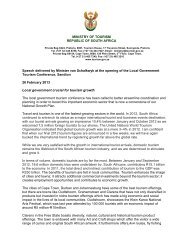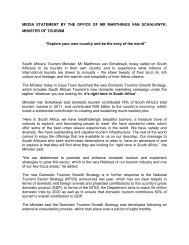<strong>The</strong> benefits <strong>of</strong> effective conflict resolution are: Increased understanding: <strong>The</strong> discussion needed to resolve conflict expands people'sawareness <strong>of</strong> the situation, giving them an insight into how they can achieve their owngoals without undermining those <strong>of</strong> other people; Increased group cohesion: When conflict is resolved effectively, team members candevelop stronger mutual respect, and a renewed faith in their ability to work together;and Improved self-knowledge: Conflict pushes individuals to examine their goals in closedetail, helping them understand the things that are most important to them, sharpeningtheir focus, and enhancing their effectiveness.Understanding the <strong>The</strong>ory: Conflict StylesIn the 1970s Kenneth Thomas and Ralph Kilmann identified five main styles <strong>of</strong> dealing withconflict that vary in their degrees <strong>of</strong> cooperativeness and assertiveness. <strong>The</strong>y argued thatpeople typically have a preferred conflict resolution style. However they also noted that differentstyles were most useful in different situations.Competitive: People who tend towards a competitive style take a firm stand, and know whatthey want. <strong>The</strong>y usually operate from a position <strong>of</strong> power, drawn from things like position, rank,expertise, or persuasive ability. This style can be useful when there is an emergency and adecision needs to be make fast; when the decision is unpopular; or when defending againstsomeone who is trying to exploit the situation selfishly. However it can leave people feelingbruised, unsatisfied and resentful when used in less urgent situations.Collaborative: People tending towards a collaborative style try to meet the needs <strong>of</strong> all peopleinvolved. <strong>The</strong>se people can be highly assertive but unlike the competitor, they cooperateeffectively and acknowledge that everyone is important. This style is useful when a you need tobring together a variety <strong>of</strong> viewpoints to get the best solution; when there have been previousconflicts in the group; or when the situation is too important for a simple trade-<strong>of</strong>f.Compromising: People who prefer a compromising style try to find a solution that will at leastpartially satisfy everyone. Everyone is expected to give up something, and the compromiserhim- or herself also expects to relinquish something. Compromise is useful when the cost <strong>of</strong>conflict is higher than the cost <strong>of</strong> losing ground, when equal strength opponents are at astandstill and when there is a deadline looming.Accommodating: This style indicates a willingness to meet the needs <strong>of</strong> others at the expense<strong>of</strong> the person’s own needs. <strong>The</strong> accommodator <strong>of</strong>ten knows when to give in to others, but canbe persuaded to surrender a position even when it is not warranted. This person is notassertive but is highly cooperative. Accommodation is appropriate when the issues matter moreto the other party, when peace is more valuable than winning, or when you want to be in aposition to collect on this “favor” you gave. However people may not return favors, and overallthis approach is unlikely to give the best outcomes.Avoiding: People tending towards this style seek to evade the conflict entirely. This style istypified by delegating controversial decisions, accepting default decisions, and not wanting tohurt anyone’s feelings. It can be appropriate when victory is impossible, when the controversyis trivial, or when someone else is in a better position to solve the problem. However in manysituations this is a weak and ineffective approach to take.Once you understand the different styles, you can use them to think about the most appropriateapproach (or mixture <strong>of</strong> approaches) for the situation you're in. You can also think about yourown instinctive approach, and learn how you need to change this if necessary.100
8.1 Using the Tool: A Conflict Resolution ProcessBased on these approaches, a starting point for dealing with conflict is to identify the overridingconflict style employed by yourself, your team or your organization.<strong>The</strong>n use the process below to resolve the conflict:Step One: Set the SceneMake sure that people understand that the conflict may be a mutual problem, which may bebest resolved through discussion and negotiation rather than through raw aggression. If you areinvolved in the conflict, emphasize the fact that you are presenting your perception <strong>of</strong> theproblem. Use active listening skills to ensure you hear and understand other’s positions andperceptions. Restate Paraphrase SummarizeAnd make sure that when you talk, you're using an adult, assertive approach rather than asubmissive or aggressive style.Step Two: Gather InformationHere you are trying to get to the underlying interests, needs, and concerns. Ask for the otherperson’s viewpoint and confirm that you respect his or her opinion and need his or hercooperation to solve the problem.Also, try to understand the conflict in objective terms: Is it affecting work performance?damaging the delivery to the client? disrupting team work? hampering decision-making? or soon. Be sure to focus on work issues and leave personalities out <strong>of</strong> the discussion.Listen with empathy and see the conflict from the other person’s point <strong>of</strong> viewIdentify issues clearly and concisely Use “I” statements Remain flexible Clarify feelingsStep Three: Agree on the ProblemThis sounds like an obvious step, but <strong>of</strong>ten different underlying needs, interests and goals cancause people to perceive problems very differently. You'll need to agree the problems that youare trying to solve before you'll find a mutually acceptable solution.Sometimes different people will see different but interlocking problems - if you can't reach acommon perception <strong>of</strong> the problem, then at the very least, you need to understand what theother person sees as the problem.Step Four: Brainstorm Possible SolutionsIf everyone is going to feel satisfied with the resolution, it will help if everyone has had fair inputin generating solutions. Brainstorm possible solutions, and be open to all ideas, including onesyou never considered before.Step Five: Negotiate a SolutionBy this stage, the conflict may be resolved: Both sides may better understand the position <strong>of</strong>the other, and a mutually satisfactory solution may be clear to all. However you may also haveuncovered real differences between your positions. This is where a technique like win-winnegotiation can be useful to find a solution that, at least to some extent, satisfies everyone.<strong>The</strong> three guiding principles here: Be Calm, Be Patient, Have Respect…101


